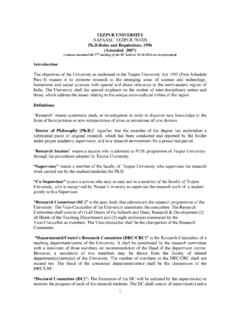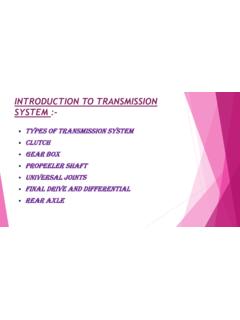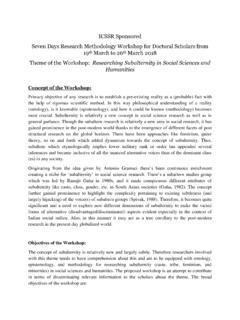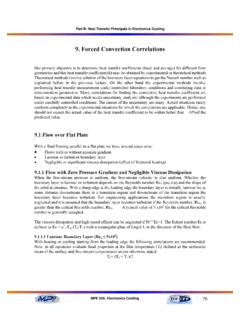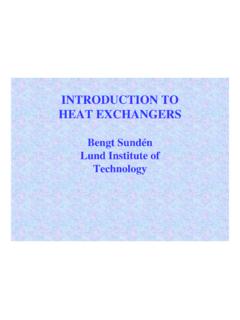Transcription of M.Tech in Mechanical Engineering (Specialization: Thermo ...
1 In Mechanical Engineering ( specialization : Thermo -Fluids Engineering ) Department of Mechanical Engineering Tezpur University 1 1. Aim of the specialization : To offer courses related to Thermal Engineering at PG level to produce manpower/human resource in the field of Thermo -Fluids Engineering for serving the Industry and academia. 2. Eligibility Criteria: The minimum eligibility for enrolment in the Programme is BE/BTech or equivalent Bachelor Degree in Mechanical , Energy and Power Engineering , Aerospace/Aeronautical or in any other relevant Engineering discipline. Preference will be given to candidates having valid GATE scores. 3. Course Structure: (i) The course contains some core courses mainly from Thermal and fluid Engineering . (ii) The course is designed incorporating some elective courses giving a wide range of choice to the students.
2 (iii) All core and elective courses involves assignment and/or mini project (iv) Further, the enrolled students will have to study two Inter-Disciplinary Courses (CBCT) offered by any other department of the University. (v) The course contains a paper called seminar where a student in consultation with faculty member will carry out literature survey in specific area of interest and periodically present his/her observations in the form of seminar presentation. (vi) A student will choose elective and IDC courses for him/her in consultation with the Programme Coordinator. in Mechanical Engineering ( specialization : Thermo -Fluids Engineering ) Department of Mechanical Engineering Tezpur University 2 Curriculum Semester Course detail Total Credits SN Code Title L T P CH Cr I 1 ME-535 Advanced Engg. Thermodynamics 3 0 0 3 3 21 2 ME-541 Advanced fluid Mechanics 3 1 0 4 4 3 ME-562 Experimental Methods in Thermal and fluid Engineering 3 0 2 7 5 4 xx-xxx Open Elective I (CBCT I) 3 5 xx-xxx Elective I 3* 6 xx-xxx Elective II 3* II 1 ME-530 Numerical methods 3 0 1 5 4 21 2 ME-548 Convective Heat and Mass transfer 3 0 0 3 3 3 xx-xxx Open Elective II (CBCT II) 3 4 xx-xxx Open Elective III (CBCT III) 3 5 xx-xxx Elective III 3* 6 xx-xxx Elective IV 3* 7 ME-593 Seminar 0 0 0 4 2 III 1 ME-611 MTech Thesis part I 12 12 IV 1 ME-612 MTech Thesis part II 12 12 Total 14 Minimum credit to be completed for award of the degree 66 * Minimum credits are shown against the elective courses.
3 The overall credit, however, may vary with the actual credits of opted elective courses (credits of other courses are fixed as shown). Syllabus ME-535: Advanced Engineering Thermodynamics L-T-P-CH-CR: 3-0-0-3-3 Review of fist and second law of thermodynamics, Maxwell equations, Joule-Thompson experiment, irreversibility and availability, exergy analysis, phase transition, types of equilibrium and stability, multi-component and multi-phase systems, equations of state, chemical thermodynamics, combustion. Third law of thermodynamics Kinetic theory of gases- introduction, basic assumption, molecular flux, equation of state for an ideal gas, collisions with a moving wall, principle of equipartition of energy, classical theory of specific heat capacity. Transport phenomena-intermolecular forces, The Van der Waals equation of state, collision cross section, mean free path Statistical thermodynamics- introduction, energy states and energy levels, macro and microscales, thermodynamic probability, B-E, F-D, M-D statistics, distribution function, partition energy, statistical interpretation of entropy, application of statistics to gases-mono-atomic ideal gas, distribution of molecular velocity, ideal gas in a gravitational field.
4 Textbooks 1. Sears, and Salinger, Thermodynamics, Kinetic Theory And Statistical Thermodynamics (Narosa Publishing House, New Delhi, 3/e, (1995) 2. Wylen and Sontag, Fundamentals of Classical Thermodynamics (Wiley Eastern Limited, New Delhi, 1985) References 1. Moran, and Shapiro, Fundamentals Of Engineering Thermodynamics (John Wiley and Sons, 6/e, 2008) 2. Zemansky, Engineering Thermodynamics (Mc Graw Hill, 2/e) 3. Bejan, Advanced Engineering Thermodynamics (John Wiley and sons, 2006) in Mechanical Engineering ( specialization : Thermo -Fluids Engineering ) Department of Mechanical Engineering Tezpur University 3 ME-541: Advanced fluid Mechanics L-T-P-CH-CR: 3-1-0-4-4 Preliminary concepts on fluid , body force, surface force, scalar and vector fields, Eulerian and Lagrangian description of flow, motion of fluid element - translation, rotation and deformation; Vorticity and strain-rate tensors, integral and differential forms of governing equations - mass, momentum and energy conservation equations, stress tensor, principle of local stress equilibrium.)
5 Cauchy s equations of motion, transport theorems, constitutive equations, Stokes law of viscosity, Navier-Stokes equations and their exact solutions, theory of hydrodynamic lubrication, flow between two concentric rotating cylinders; Stokes first and second problems, Laminar boundary layer, Prandtl s boundary layer theory, similarity solution, momentum integral equation for boundary layer, Karman Pohlhausen approximation; Hydrodynamic stability - stability in elementary flow fields, introduction to turbulent flow, review of compressible flow - isentropic flow, flow with area change, flow with heat transfer, flow with friction, sonic flow, supersonic flow, shock waves, Prandtl Mayor s equation; Assignment and mini-project. Textbooks 1. Muralidhar, K. and Biswas, G. Advanced Engineering fluid Mechanics. (Narosa Publishing House, 2005) 2.
6 Binder, Advanced fluid Dynamics (Prentice Hall,1958) References 1. Schlichting, H. Boundary Layer Theory (McGraw-Hill, 1979) 2. White, Viscous fluid Flow (McGraw-Hill, 2011) 3. Munson, , Young, and Okiishi, Fundamental of fluid Mechanics (John Wiley & Sons, 2002) 4. Panton, Incompressible Flow (Wiley, 2005) 5. Anderson, Modern Compressible Flow with Historical Perspective (McGraw-Hill, 1990) ME-562: Experimental Methods in Thermal and fluid Engineering L-T-P-CH-CR: 3-0-2-7-5 Theory and experimentation in Engineering - problem solving approaches, types of Engineering experiments, computer simulation and physical experimentation; Generalized measuring system, instruments (both first and second order) response subjected to different inputs signals, types of inputs, analog and digital signals, standards, calibration and uncertainty, measurement system - performance characteristics, selection of instruments and design of experiments Analysis of experimental data error analysis, uncertainty analysis, data reduction techniques, statistical analysis of data, regression analysis correlations, probability distributions and curve fitting.
7 Thermometry - heat flux measurement - Measurement of derived quantities - torque, power, thermophysical properties - radiation and surface properties. Measurement of pressure, flow velocity measurement, wind tunnels and flow visualization, measurement of temperature, optical methods of measurements, hot wire anemometry, hot film anemometry, laser Doppler anemometer, instrumentation in two-phase flows, particle image velocimetry technique; Textbooks 1. Holman, J. Experimental Methods for Engineers, 7th ed., McGraw-Hill, 2007. 2. Rathakrishnan, E. Instrumentation, Measurements and Experiments in Fluids, Taylor & Francis, New Delhi, 2007. References 1. Wheeler, and Ganji, Introduction to Engineering Experimentation, Prentice Hall, 2003 2. Reddy T. A. Applied Data Analysis and Modeling for Energy Engineers and Scientists, Springer, London, 2011.
8 3. Beckwith, , Marangoni, and Lienhard, Mechanical Measurements, 2nd ed., Prentice Hall, 2009. 4. Tropeia, C., Yarin, A., Foss, Handbook of Experimental fluid Mechanics, Springer, Berlin, 2007. 5. Goldstein, fluid Mechanics Measurements, Taylor & Francis, Philadelphia, 1996. 6. Doeblin, Engineering Experimentation, McGraw-Hill, New York, 1995 in Mechanical Engineering ( specialization : Thermo -Fluids Engineering ) Department of Mechanical Engineering Tezpur University 4 ME-530: Numerical Methods L-T-P-CH-CR: 3-0-1-5-4 Roots of single-variable nonlinear equations: Bracketing methods, bisection method, false position method, fixed point iteration, Netwon-Raphson method and secant method, solution of specific thermal Engineering related problems using some of the above methods Roots of singe-variable polynomials: Polynomial deflation, Bairstow s method and Muller method Numerical differentiation: Finite difference approximations of first and second order derivatives Numerical integration.
9 Newton-Cotes Methods, Gauss quadrature Linear system of equations: Direct Methods: Gauss elimination, Gauss-Jordan method, matrix inversion, LU decomposition Iterative methods: Gauss-Seidel, Jacobi, Relaxation methods Eigenvalues and eigenvectors: Direct power method, inverse power method and shifted power method Similarity transformation: QR decomposition with Householder transformation Numerical solution of nonlinear equations: Fixed point iteration, Newton s method Ordinary differential equations: Euler and Runge-Kutta methods for initial value problem, shooting and finite difference methods for boundary value problems, predictor-corrector method, eigenvalue problems, solution of boundary layer equations using Newton Raphson method and 4th order Runge-kutta Method Partial differential equations: Classification of PDEs and their characteristics, parabolic, elliptic and hyperbolic equations, Numerical solution of parabolic, elliptic and hyperbolic equations Laboratory component: The laboratory component will include computer programming of the methods described and also some other assignments through which students will be able to acquire the skill of writing computer programs/codes on numerical algorithms and solving real life problems related to thermal Engineering .
10 Textbooks 1. Gerald and Wheatley, Applied Numerical Analysis, Fifth edition, Addison-Wesley, 1994 2. Conte and C. de Boor, Elementary Numerical Analysis, Third Edition, Tata McGraw-Hill Education, 2005. 3. Hildebrand, Introduction to Numerical Analysis, Second (Revised) Edition, Courier Dover Publications, 1987. References 1. E. Kreyszig, Advanced Engineering Mathematics, Tenth Ed., John Wiley and Sons, 2010 2. R. L. Burden and J. D. Faires, Numerical Analysis, 9th Edition, Brooks/Cole, 2011 ME-548: Convective heat and mass transfer L-T-P-CH-CR: 3-0-0-3-3 Introduction: Introduction to forced and free convection, derivation of governing equations of momentum, energy and species transport, order of magnitude analysis, Reynolds analogy Convective heat transfer internal flows: Concept of hemodynamically developing and developed flows, thermally developing flows (Graetz problem) and thermally developed laminar flow, Overview of steady laminar forced convection in Hagen Poiseuille flow, Plane Poiseuille flow, and Couette flow, solutions of coupled momentum and energy equations in developing and fully developed flow and heat transfer problems with constant wall flux and constant wall temperature boundary conditions.

